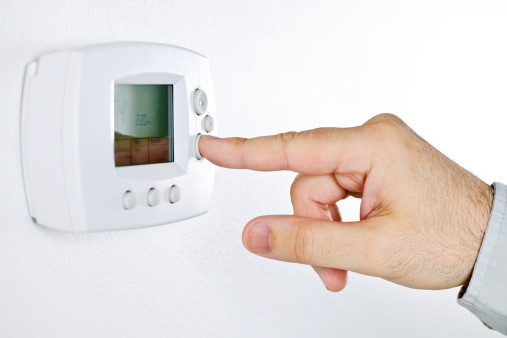This is a very common question that we hear often. The answer can be different for everyone so here are some basic questions to ask yourself first.
- How Regular is my Schedule?
- Is my comfort more important than my pocketbook?
- Do I have a high efficiency heating system?
- What type of heating system do I have?
After answering these questions you now have the information you need to help you determine how you should set your thermostat.
Regular Schedule
If your schedule is very regular, meaning you leave your home and come home around the same time at least five days a week, then a programmable thermostat will work great for your needs. Higher end programmable thermostats can custom program each day differently, however, each day will always have to be the same. For instance, let’s say you get home at 7pm on Monday and Wednesday nights, but you’re home at 5pm during the other days; you’re able to program your thermostat to exactly your schedule. Additionally, you can set your thermostat and leave it, and only worry about changing it when your schedule calls for it.
Set Your Thermostat for Comfort
If your comfort is most important to you, then absolutely set your thermostat to a comfortable temperature (usually between 70-74), and leave it there while you are home and awake. Your energy bill will depend on how well your house is insulated, the number of areas you have heat loss from (windows, door, etc.), as well as the type of heating system you have (gas/electric furnace or radiant heating).
Some systems can be very costly to maintain 74 degrees, while other homes may be able to keep a steady 74 degrees with a much lower impact on their energy bill. During a cold front, your system burns more fuel to maintain 74 than 68. The colder it is, the more the outdoors draws a faster heat transfer, which causes your unit to turn on more often to maintain your desired temperature.
A digital thermostat can actually help keep your bills down by maintaining a 1-degree difference between the set point on your thermostat and the actual temperature. A smart thermostat can be a great tool in helping you manage the temperature of your home. Smart thermostats (like Sensi, Nest & Honeywell Lyric) are “smart” because they can learn from your behaviors, show your energy use in real time and allow you to control the temperature of your home with your smartphone. You can even use a setting called, Geo-fencing, that allows you to program your thermostat to turn on when you are a certain number of miles from your home. For example, you could set your thermostat to turn on when your phone enters within a two-mile radius of your house, allowing your house to get warm and toasty before you even walk in the door.
Be sure that your thermostat is in a location within your home that will give you an accurate temperature measurement. You wouldn’t want to place it behind a television or directly in sunlight, for example. Because these give off extra heat, it can cause your thermostat to read that your home is at a higher temperature than it really is. Your house could be cold, even though the thermostat is reading 70 degrees. You can get your thermostat moved to a better location in your home (preferably in a shaded area near a return duct), or you can also choose to use a wireless thermostat that you can place anywhere.
High-efficiency Heating Systems
If you have a high-efficiency heating system (meaning 90% efficient or higher) you should have lower energy bills even if you maintain warmer temperatures in your home. Of course, other factors like how well your home is insulated will still affect how well the heat is retained.
Forced Air Furnaces
Gas or electric furnaces, also known as forced-air furnaces, are the most popular type of heating in Albuquerque and are among the most effective ways to warm your home. A forced air furnace pushes air through several ducts, vents and plenums to evenly carry heat throughout your home.
You’ll want to set the thermostat at different temperatures based on when you’re home and when you’re awake or asleep. If your home is insulated well and maintains a comfortable temperature, then you can set the temperature much lower (around 65 degrees) when you’re not home. If your house is not insulated well, it’s smart to keep your home warmer when you’re away. This helps keep your house from getting too cold while you’re away and you’ll have an easier time heating your house when you are home. Also, if you have a small home or if it heats up quickly, then it’s good to set your thermostat lower. This helps you from using unnecessary energy when you’re not home.
While you can actually save about 1% on your energy bill per degree you turn your thermostat down, you should avoid turning your heater completely off. Keeping your home slightly warmed will help keep your pipes from freezing. You may think turning off your heater completely will help save you money, but when it is time to turn your heater back on, it could actually take more energy to warm your home back up to 68 degrees than it would to just maintain a consistent 65 degrees throughout the day. The lowest you should set your thermostat to is 55 degrees, without worrying about your pipes freezing (via Energy.gov).
Radiant Heating Systems
If you have a radiant heating system, whether floor or baseboard heaters, it’s best to set your thermostats to one temperature and leave it at that temperature all winter long. Because ambient heat takes so much longer to warm up, it’s important to maintain a core temperature and it’s best not to make temperature adjustments.
If you need assistance with your heating system or need a furnace repair TLC is always here for you with around the clock service. You can trust TLC to keep you comfortable.
Download our free furnace buying guide:
 This guide was designed to provide you with valuable information when replacing your furnace. If you are considering replacing your furnace get all the information you need to make an informed decision.
This guide was designed to provide you with valuable information when replacing your furnace. If you are considering replacing your furnace get all the information you need to make an informed decision.

